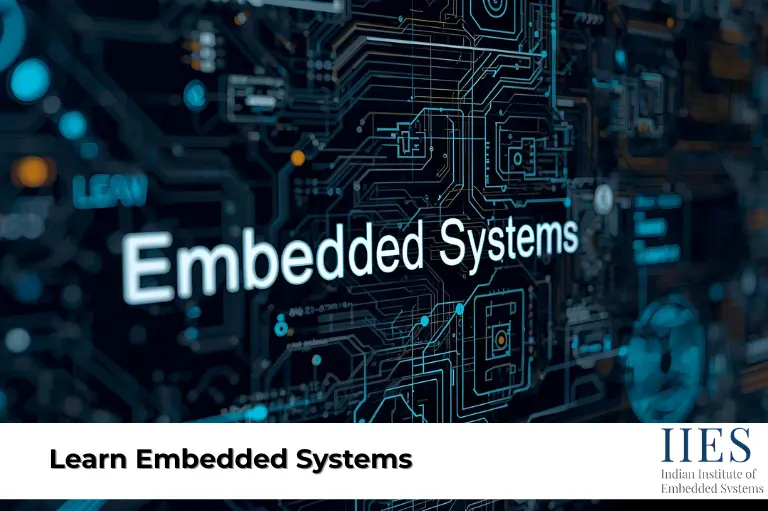
Embedded systems power everyday devices like mobiles, cars, and medical tools. Learn Embedded Systems opens career paths in IoT, robotics, and electronics. This roadmap gives beginners and students a clear step-by-step guide to building skills in embedded systems through practical learning.
The best way to learn embedded systems is to start with basics of electronics, embedded c programming, and hands-on projects using boards like Arduino or STM32, then move toward microcontrollers, RTOS, protocols, and advanced IoT applications.
Embedded systems are everywhere—your washing machine, fitness band, or even modern cars. They are small but powerful computer systems that manage specific tasks. For students, engineers, and hobbyists, learning embedded systems unlocks opportunities in:
With industries moving toward automation and smart technologies, demand for embedded engineers is growing worldwide. Structured embedded systems courses and embedded programming certification programs help beginners accelerate their learning.
Before diving deep, it’s important to know what embedded systems are and how they work. Basics create the foundation for advanced learning.
Electronics knowledge is essential because every embedded system depends on circuits. A clear grasp of components makes hardware easy to handle.
This step makes you comfortable with the building blocks of embedded devices.
Programming connects hardware with logic. Embedded C programming and embedded C course skills are crucial.
Development boards give you practical learning. Starting with Arduino or STM32 helps you apply your knowledge directly to projects.
Pro Tip: Begin with Arduino, then gradually move to STM32 once you are confident.
Projects transform theory into skills. Small experiments help build confidence in hardware-software integration.
Each project improves your understanding of embedded system design.
Microcontrollers are the heart of embedded systems. Learning how they store, process, and communicate is key for professional growth.
Datasheets may look complex, but they’re your best friend for embedded systems certification.
Many embedded devices run multiple tasks at once, like reading a sensor while displaying data. This needs an RTOS.
This step moves you closer to embedded systems course industry-level development.
Protocols allow devices to talk to each other. Learning UART, SPI, I2C, and CAN ensures smooth data transfer between components.
Example: Connect multiple sensors with I2C and display data on a screen using your automotive embedded systems course knowledge.
Sensors collect information from the environment, while actuators perform actions. Together, they make embedded systems interactive.
Build projects like smart door locks, automatic fans, or wearable health trackers using embedded programming certification skills.
Debugging ensures your system works reliably. Optimization helps save memory and processing power in resource-limited devices.
Good debugging saves hours of frustration and makes you a reliable developer.
Version control keeps your work safe and organized. Collaboration tools like GitHub help you share and grow in a community.
This step also helps you create a professional portfolio in embedded system design.
The embedded field evolves quickly. Staying updated with new tools and trends keeps your skills sharp and industry-ready.
If you want structured and career-focused learning, joining a professional training institute is the best choice. At IIES – Indian Institute of Embedded Systems, Bangalore, you get:
At IIES, students don’t just learn theory—they build real-world projects, gain confidence, and prepare for high-demand embedded system careers.

Learning embedded systems is a journey of practice, patience, and curiosity. Start with basics, build small projects, and keep moving to advanced topics like RTOS and IoT. With continuous learning and real-world projects, you can grow from beginner to skilled embedded engineer ready for industry roles.
Start with basics of electronics, then learn programming languages like C/C++, and begin with small hands-on projects using Arduino or Raspberry Pi.
While not mandatory, basic knowledge of electronics is highly recommended as it helps understand microcontrollers, circuits, and embedded system design.
C and C++ are widely used. Python is useful for Raspberry Pi and higher-level scripting tasks.
Arduino is easier for beginners due to its simplicity and large community. Raspberry Pi is more powerful and suitable for advanced projects with Linux and Python.
It varies depending on your dedication and practice. Consistent hands-on learning over a few months can make you proficient in basic embedded systems.
Yes, with a solid portfolio of projects and practical skills, you can qualify for entry-level embedded systems jobs or internships.
Indian Institute of Embedded Systems – IIES